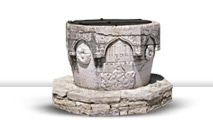
- Sečovlje Salt Pans - Dragonja River Valley
- Sv. Peter - Nova vas - Padna
- Pomjan - Nature Park: Karst Edge - Socerb
- Črni Kal - Osp - Kubed
- Momjan - Grožnjan - Pietrapelosa - Mirna
- Baštija - Kostanjica - Parenzana
- Oprtalj - Završje - Livade - Zrenj
- Istarske toplice - Motovun Forest - Višnjan
- Cave Mramornica - Feštini Kingdom - Cave Baredine
- Lim Bay - Kloštar - Kontija - Dvigrad
- Kanfanar - Bale - Palud - Vodnjan - Brijuni - Fažana
- Svetvinčenat - Tinjan - Pićan - Gračišće
- Belaj - Šumber - Kožljak - Paz
- Čepićko Field - Kršan - Boljun Castle - Lupoglav
- Plomin - Kvarner Gulf - Brseč
- Nature park Učka - Mošćenice
Kanfanar - Bale - Palud - Vodnjan - Brijuni - Fažana
Kanfanar
Although numerous finds from prehistory – the Neolithic culture, Bronze Age tumuli, remains of Iron Age hill-forts, parts of settlements of ancient Histri on seven locations – create a multi-layered story about the first and later life in Kanfanar, in historic recordings the most striking is the story about the close ties between Kanfanar and Dvigrad. It was an inseparable bond, from as early as the Middle Ages. History has it that Kanfanar was founded by the inhabitants of ancient Dvigrad who fled from invaders and diseases. They brought along everything they considered sacred and precious, such as the flagpole from the 15th c. that presently stands in the square or the magnificent pulpit in the Church of St. Silvester. As Kanfanar expanded, the church from the 13th c. became too small. That is why on that site, a new and larger one was built in the 17th c. – presently the Parish Church of St. Silvester. From the Dvigrad basilica of St. Sophia, the aforementioned pulpit was transferred into it together with the church furnishings and liturgical objects. Kanfanar developed even more when the railroad to Pula was built during the Austrian administration and the town got a large and modern railroad station. A branching road for Rovinj was built as well, making Kanfanar the only railroad junction in Istria.
In the town is the Church of St. Valentine from the 18th c. built on the site of an earlier one. Outside the town is the Church of St. Agatha from the 12th c. with preserved frescoes. Along the road to Dvigrad are remains of the Benedictine monastery with a Romanesque-Gothic Church of St. Petronella.
Напечатай страницу Отправь другу
















